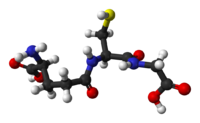
Photo from wikipedia
Here, we present the draft genome sequence of Pseudomonas sp. GC01, a cadmium-resistant Antarctic bacterium capable of biosynthesizing CdS fluorescent nanoparticles (quantum dots, QDs) employing a unique mechanism involving the… Click to show full abstract
Here, we present the draft genome sequence of Pseudomonas sp. GC01, a cadmium-resistant Antarctic bacterium capable of biosynthesizing CdS fluorescent nanoparticles (quantum dots, QDs) employing a unique mechanism involving the production of methanethiol (MeSH) from methionine (Met). To explore the molecular/metabolic components involved in QDs biosynthesis, we conducted a comparative genomic analysis, searching for the genes related to cadmium resistance and sulfur metabolic pathways. The genome of Pseudomonas sp. GC01 has a 4,706,645 bp size with a 58.61% G+C content. Pseudomonas sp. GC01 possesses five genes related to cadmium transport/resistance, with three P-type ATPases (cadA, zntA, and pbrA) involved in Cd-secretion that could contribute to the extracellular biosynthesis of CdS QDs. Furthermore, it exhibits genes involved in sulfate assimilation, cysteine/methionine synthesis, and volatile sulfur compounds catabolic pathways. Regarding MeSH production from Met, Pseudomonas sp. GC01 lacks the genes E4.4.1.11 and megL for MeSH generation. Interestingly, despite the absence of these genes, Pseudomonas sp. GC01 produces high levels of MeSH. This is probably associated with the metC gene that also produces MeSH from Met in bacteria. This work is the first report of the potential genes involved in Cd resistance, sulfur metabolism, and the process of MeSH-dependent CdS QDs bioproduction in Pseudomonas spp. strains.
Journal Title: Genes
Year Published: 2021
Link to full text (if available)
Share on Social Media: Sign Up to like & get
recommendations!